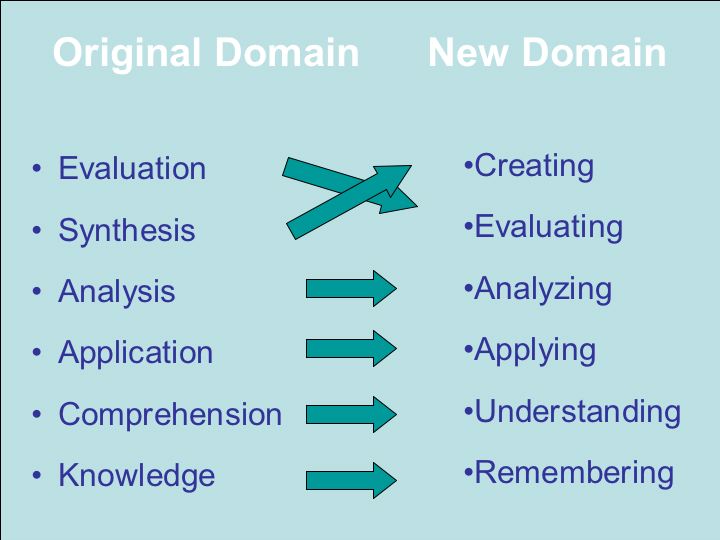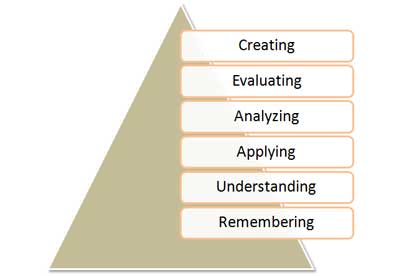Note: This site is moving to KnowledgeJump.com. Please reset your bookmark.
Bloom's Taxonomy of Learning Domains
Bloom's Taxonomy was created in 1956 under the leadership of educational psychologist Dr Benjamin Bloom in order to promote higher forms of thinking in education, such as analyzing and evaluating concepts, processes, procedures, and principles, rather than just remembering facts (rote learning). It is most often used when designing educational, training, and learning processes.
The Three Domains of Learning
The committee identified three domains of educational activities or learning (Bloom, et al. 1956):
-
Cognitive: mental skills (knowledge)
-
Affective: growth in feelings or emotional areas (attitude or self)
-
Psychomotor: manual or physical skills (skills)
Since the work was produced by higher education, the words tend to be a little bigger than we normally use. Domains may be thought of as categories. Instructional designers, trainers, and educators often refer to these three categories as KSA (Knowledge [cognitive], Skills [psychomotor], and Attitudes [affective]). This taxonomy of learning behaviors may be thought of as “the goals of the learning process.” That is, after a learning episode, the learner should have acquired a new skill, knowledge, and/or attitude.
While the committee produced an elaborate compilation for the cognitive and affective domains, they omitted the psychomotor domain. Their explanation for this oversight was that they have little experience in teaching manual skills within the college level. However, there have been at least three psychomotor models created by other researchers.
Their compilation divides the three domains into subdivisions, starting from the simplest cognitive process or behavior to the most complex. The divisions outlined are not absolutes and there are other systems or hierarchies that have been devised, such as the Structure of Observed Learning Outcome (SOLO). However, Bloom's taxonomy is easily understood and is probably the most widely applied one in use today.
Cognitive Domain

The cognitive domain involves knowledge and the development of intellectual skills (Bloom, 1956). This includes the recall or recognition of specific facts, procedural patterns, and concepts that serve in the development of intellectual abilities and skills. There are six major categories of cognitive an processes, starting from the simplest to the most complex (see the table below for an in-depth coverage of each category):
- Knowledge
- Comprehension
- Application
- Analysis
- Synthesis
- Evaluation
The categories can be thought of as degrees of difficulties. That is, the first ones must normally be mastered before the next one can take place.
Bloom's Revised Taxonomy
Lorin Anderson, a former student of Bloom, and David Krathwohl revisited the cognitive domain in the mid-nineties and made some changes, with perhaps the three most prominent ones being (Anderson, Krathwohl, Airasian, Cruikshank, Mayer, Pintrich, Raths, Wittrock, 2000):
- changing the names in the six categories from noun to verb forms
- rearranging them as shown in the chart below
- creating a processes and levels of knowledge matrix


This new taxonomy reflects a more active form of thinking and is perhaps more accurate. The new version of Bloom's Taxonomy, with examples and keywords is shown below, while the old version may be found here
Table of the Revised Cognitive Domain
Category |
Examples, key words (verbs), and technologies for learning (activities) |
Remembering: Recall or retrieve previous learned information. |
Examples: Recite a policy. Quote prices from memory to a customer. Recite the safety rules. Key Words: defines, describes, identifies, knows, labels, lists, matches, names, outlines, recalls, recognizes, reproduces, selects, states Technologies: book marking, flash cards, rote learning based on repetition, reading |
Understanding: Comprehending the meaning, translation, interpolation, and interpretation of instructions and problems. State a problem in one's own words. |
Examples: Rewrite the principles of test writing. Explain in one's own words the steps for performing a complex task. Translate an equation into a computer spreadsheet. Key Words: comprehends, converts, defends, distinguishes, estimates, explains, extends, generalizes, gives an example, infers, interprets, paraphrases, predicts, rewrites, summarizes, translates Technologies: create an analogy, participating in cooperative learning, taking notes, storytelling, Internet search |
Applying: Use a concept in a new situation or unprompted use of an abstraction. Applies what was learned in the classroom into novel situations in the work place. |
Examples: Use a manual to calculate an employee's vacation time. Apply laws of statistics to evaluate the reliability of a written test. Key Words: applies, changes, computes, constructs, demonstrates, discovers, manipulates, modifies, operates, predicts, prepares, produces, relates, shows, solves, uses Technologies: collaborative learning, create a process, blog, practice |
Analyzing: Separates material or concepts into component parts so that its organizational structure may be understood. Distinguishes between facts and inferences. |
Examples: Troubleshoot a piece of equipment by using logical deduction. Recognize logical fallacies in reasoning. Gathers information from a department and selects the required tasks for training. Key Words: analyzes, breaks down, compares, contrasts, diagrams, deconstructs, differentiates, discriminates, distinguishes, identifies, illustrates, infers, outlines, relates, selects, separates Technologies: Fishbowls, debating, questioning what happened, run a test |
Evaluating: Make judgments about the value of ideas or materials. |
Examples: Select the most effective solution. Hire the most qualified candidate. Explain and justify a new budget. Key Words: appraises, compares, concludes, contrasts, criticizes, critiques, defends, describes, discriminates, evaluates, explains, interprets, justifies, relates, summarizes, supports Technologies: survey, blogging |
Creating: Builds a structure or pattern from diverse elements. Put parts together to form a whole, with emphasis on creating a new meaning or structure. |
Examples: Write a company operations or process manual. Design a machine to perform a specific task. Integrates training from several sources to solve a problem. Revises and process to improve the outcome. Key Words: categorizes, combines, compiles, composes, creates, devises, designs, explains, generates, modifies, organizes, plans, rearranges, reconstructs, relates, reorganizes, revises, rewrites, summarizes, tells, writes Technologies: Create a new model, write an essay, network with others |
Cognitive Processes and Levels of Knowledge Matrix
Bloom's Revised Taxonomy not only improved the usability of it by using action words, but added a cognitive and knowledge matrix.
While Bloom's original cognitive taxonomy did mention three levels of knowledge or products that could be processed, they were not discussed very much and remained one-dimensional:
- Factual - The basic elements students must know to be acquainted with a discipline or solve problems.
- Conceptual – The interrelationships among the basic elements within a larger structure that enable them to function together.
- Procedural - How to do something, methods of inquiry, and criteria for using skills, algorithms, techniques, and methods.
In Krathwohl and Anderson's revised version, the authors combine the cognitive processes with the above three levels of knowledge to form a matrix. In addition, they added another level of knowledge - metacognition:
- Metacognitive – Knowledge of cognition in general, as well as awareness and knowledge of one’s own cognition.
When the cognitive and knowledge dimensions are arranged in a matrix, as shown below, it makes a nice performance aid for creating performance objectives:
The Cognitive Dimension
| The Knowledge Dimension | Remember | Under-stand | Apply | Analyze | Evaluate | Create |
|---|---|---|---|---|---|---|
| Factual | ||||||
| Conceptual | ||||||
| Procedural | ||||||
| Metacognitive |
However, others have identified five contents or artifacts (Clark, Chopeta, 2004; Clark, Mayer, 2007):
- Facts - Specific and unique data or instance.
- Concepts - A class of items, words, or ideas that are known by a common name, includes multiple specific examples, shares common features. There are two types of concepts: concrete and abstract.
- Processes - A flow of events or activities that describe how things work rather than how to do things. There are normally two types: business processes that describe work flows and technical processes that describe how things work in equipment or nature. They may be thought of as the big picture, of how something works.
- Procedures - A series of step-by-step actions and decisions that result in the achievement of a task. There are two types of actions: linear and branched.
- Principles - Guidelines, rules, and parameters that govern. It includes not only what should be done, but also what should not be done. Principles allow one to make predictions and draw implications. Given an effect, one can infer the cause of a phenomena. Principles are the basic building blocks of causal models or theoretical models (theories).
Thus, the new matrix would look similar to this:
The Cognitive Dimension
| The Knowledge Dimension | Remember | Under-stand | Apply | Analyze | Evaluate | Create |
|---|---|---|---|---|---|---|
| Facts | ||||||
| Concepts | ||||||
| Processes | ||||||
| Procedures | ||||||
| Principles | ||||||
| Metacognitive |
An example matrix that has been filled in might look something like this:
| The Knowledge Dimension | Remember | Under-stand | Apply | Analyze | Evaluate | Create |
|---|---|---|---|---|---|---|
| Facts | list | para-phrase | classify | outline | rank | categorize |
| Concepts | recall | explains | show | contrast | criticize | modify |
| Processes | outline | estimate | produce | diagram | defend | design |
| Procedures | reproduce | give an example | relate | identify | critique | plan |
| Principles | state | converts | solve | different-iates | conclude | revise |
| Meta-cognitive | proper use | interpret | discover | infer | predict | actualize |
Next Steps
Review
Useful Links
-
Learning Strategies: Using Bloom's Taxonomy
References
Anderson, L.W., Krathwohl, D.R., Airasian, P.W., Cruikshank, K.A., Mayer, R.E., Pintrich, P.R., Raths, J., Wittrock, M.C. (2001). A Taxonomy for Learning, Teaching, and Assessing: A revision of Bloom's Taxonomy of Educational Objectives. New York: Pearson, Allyn & Bacon.
Bloom, B.S. (Ed.). Engelhart, M.D., Furst, E.J., Hill, W.H., Krathwohl, D.R. (1956). Taxonomy of Educational Objectives, Handbook I: The Cognitive Domain. New York: David McKay Co Inc.
Clark, R., Chopeta, L. (2004). Graphics for Learning : Proven Guidelines for Planning, Designing, and Evaluating Visuals in Training Materials . San Francisco: Jossey-Bass/Pfeiffer.

